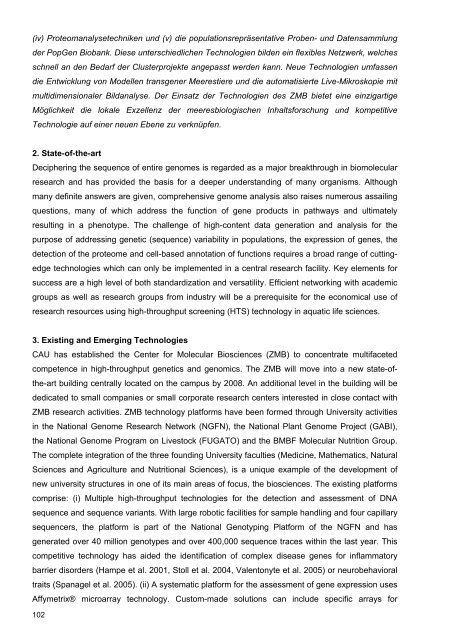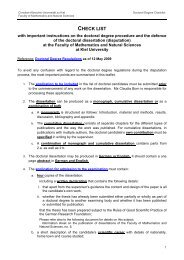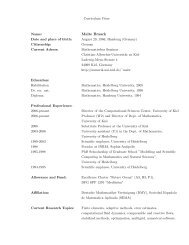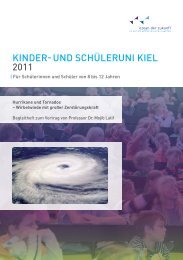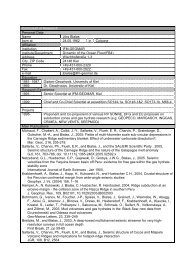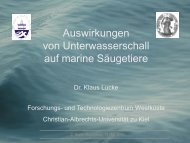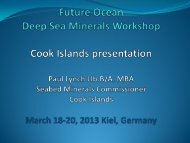Untitled - The Future Ocean
Untitled - The Future Ocean
Untitled - The Future Ocean
- No tags were found...
You also want an ePaper? Increase the reach of your titles
YUMPU automatically turns print PDFs into web optimized ePapers that Google loves.
(iv) Proteomanalysetechniken und (v) die populationsrepräsentative Proben- und Datensammlungder PopGen Biobank. Diese unterschiedlichen Technologien bilden ein flexibles Netzwerk, welchesschnell an den Bedarf der Clusterprojekte angepasst werden kann. Neue Technologien umfassendie Entwicklung von Modellen transgener Meerestiere und die automatisierte Live-Mikroskopie mitmultidimensionaler Bildanalyse. Der Einsatz der Technologien des ZMB bietet eine einzigartigeMöglichkeit die lokale Exzellenz der meeresbiologischen Inhaltsforschung und kompetitiveTechnologie auf einer neuen Ebene zu verknüpfen.2. State-of-the-artDeciphering the sequence of entire genomes is regarded as a major breakthrough in biomolecularresearch and has provided the basis for a deeper understanding of many organisms. Althoughmany definite answers are given, comprehensive genome analysis also raises numerous assailingquestions, many of which address the function of gene products in pathways and ultimatelyresulting in a phenotype. <strong>The</strong> challenge of high-content data generation and analysis for thepurpose of addressing genetic (sequence) variability in populations, the expression of genes, thedetection of the proteome and cell-based annotation of functions requires a broad range of cuttingedgetechnologies which can only be implemented in a central research facility. Key elements forsuccess are a high level of both standardization and versatility. Efficient networking with academicgroups as well as research groups from industry will be a prerequisite for the economical use ofresearch resources using high-throughput screening (HTS) technology in aquatic life sciences.3. Existing and Emerging TechnologiesCAU has established the Center for Molecular Biosciences (ZMB) to concentrate multifacetedcompetence in high-throughput genetics and genomics. <strong>The</strong> ZMB will move into a new state-ofthe-artbuilding centrally located on the campus by 2008. An additional level in the building will bededicated to small companies or small corporate research centers interested in close contact withZMB research activities. ZMB technology platforms have been formed through University activitiesin the National Genome Research Network (NGFN), the National Plant Genome Project (GABI),the National Genome Program on Livestock (FUGATO) and the BMBF Molecular Nutrition Group.<strong>The</strong> complete integration of the three founding University faculties (Medicine, Mathematics, NaturalSciences and Agriculture and Nutritional Sciences), is a unique example of the development ofnew university structures in one of its main areas of focus, the biosciences. <strong>The</strong> existing platformscomprise: (i) Multiple high-throughput technologies for the detection and assessment of DNAsequence and sequence variants. With large robotic facilities for sample handling and four capillarysequencers, the platform is part of the National Genotyping Platform of the NGFN and hasgenerated over 40 million genotypes and over 400,000 sequence traces within the last year. Thiscompetitive technology has aided the identification of complex disease genes for inflammatorybarrier disorders (Hampe et al. 2001, Stoll et al. 2004, Valentonyte et al. 2005) or neurobehavioraltraits (Spanagel et al. 2005). (ii) A systematic platform for the assessment of gene expression usesAffymetrix® microarray technology. Custom-made solutions can include specific arrays for102


